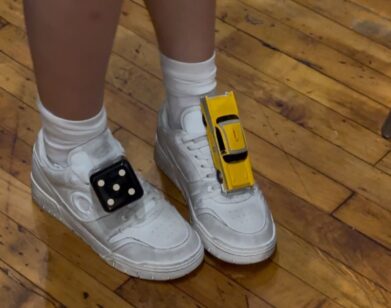Kimberly Ovitz Rides Forward

Kimberly Ovitz couldn’t stand up when she met Karl Lagerfeld, and she couldn’t make Brad Pitt laugh, but she’s ready for a fashion empire. Fabiola Beracasa asks her how she’s getting it done:
FABIOLA BERACASA: How did you get into fashion?
KIMBERLY OVITZ: Every summer since elementary school, I tried to find jobs in the fashion industry to get experience and teach myself.
BERACASA: Are your parents involved in fashion?
OVITZ: Not at all. My dad is in entertainment and my mom breeds horses. (LEFT: FROM SPRING/SUMMER 2009)
BERACASA: You have a little bit of an equestrian flair in your collection. Is that from your mom?
OVITZ: Absolutely, I grew up riding horses. I’m trying to build the brand-the core of it by being around an equestrian lifestyle.
BERACASA: So tell me, what was your first job in fashion?
OVITZ: The first one was J.Crew, when I was 15 or 16. I was in New York for the senior women’s designer Jenna Lyons, who is now the creative director. It taught me a lot about merchadising meetings and doing color stories and fittings.
BERACASA: What has been your favorite job in fashion?
OVITZ: The coolest experience I had was working with Herb Ritts. I’m also a photographer. He would stop a whole shoot to let me look through the lens. Not snobby and just totally cool.
BERACASA: Any kind of most embarrassing moments from any of these jobs-where you were like “Oh my god.”
OVITZ: I don’t have any shame. There was one at Chanel in Paris, when they first introduced me and another intern to Karl. I was in such awe that I literally—he came so close to me, and I didn’t stand up. I wrote him an apology letter. I could tell he thought it was disrespectful to me.
BERACASA: Did he ever mention it to you after?
OVITZ: Um, yeah.
BERACASA: What did he say?
OVITZ: I don’t know if I want to reveal that, but I’m glad I wrote the apology letter. That’s all I can say. Then when I was with Herb, we were doing a shoot with Brad Pitt on the beach…
BERACASA: Yum.
OVITZ: And Herb was trying to make Brad laugh and he was like “Kim, get Brad to laugh.” So I start to do something ridiculous like jumping jacks. I just remember leaving the shoot being like, “What the fuck was I doing?”
BERACASA: [LAUGHS] Did he laugh at all?
OVITZ: No, he made himself laugh. You can tell he made himself laugh to humor me.
BERACASA: Those are such good ones! Tell me a little bit about your collection, your ideal client or woman?
OVITZ: That’s a lot of questions. As I said before I’m trying to build an American equestrian lifestyle brand, and I’m trying to hit a huge demographic. Like a cool sophisticated woman in her 20s, but then also appealing to my mom in her 60s. And every season is inspired by a different artist.
BERACASA: Can you elaborate on the artist part?
OVITZ: You know I studied art history at Brown—
BERACASA: I’m just going to ask you what you didn’t study and it’ll be like two answers.
OVITZ: [LAUGHS] I grew up around art. My dad was really passionate about it.
BERACASA: Was he an art collector?
OVITZ: Yeah, so he always took me to museums. He collects a huge range, and a lot of Minimalism. He likes the period of Franz Klein, Sol Le Witt. He also has Picassos.
BERACASA: So you’re inspired by modern art?
OVITZ: Absolutely, modern. I think it’s reflected in my clothing. They have very modern angles and shapes and silhouettes. You probably saw Fall 2009. That was Jasper Johns, it was his White Flag painting and also his black and white hatch-mark paintings. There was a literal inspiration and then the juxtaposition of the angles that he painted with. I did pleating, but also based the collection on his intention. Johns’ work forces viewers to redefine familiar objects for themselves.
BERACASA: What is the 2010 collection?
OVITZ: I can’t totally talk about the inspiration yet, but I’m totally psyched for you to see it if you’re in New York. I hope you’ll come to my presentation.
BERACASA: Oh yeah! I’ll be there.
OVITZ: It’s my first so it’s very exciting.
BERACASA: Cool, do you feel like your pieces are versatile day to night? That’s important, everyone is a working woman these days.
OVITZ: I even used the example of the piece that I’ve become known for. That black long sleeved dress with the cut outs in the back, which was about reinventing the Little Black Dress. ButI don’t’ remember what I was talking about before.
BERACASA: Versatility.
OVITZ: Oh right. You can literally throw on a blazer and go to work and look really sophisticated and then go out and take off the blazer and look really simple, understated, sexy.
See more of Fabiola Beracasa on Vanity Fair’s site, and on ours.






